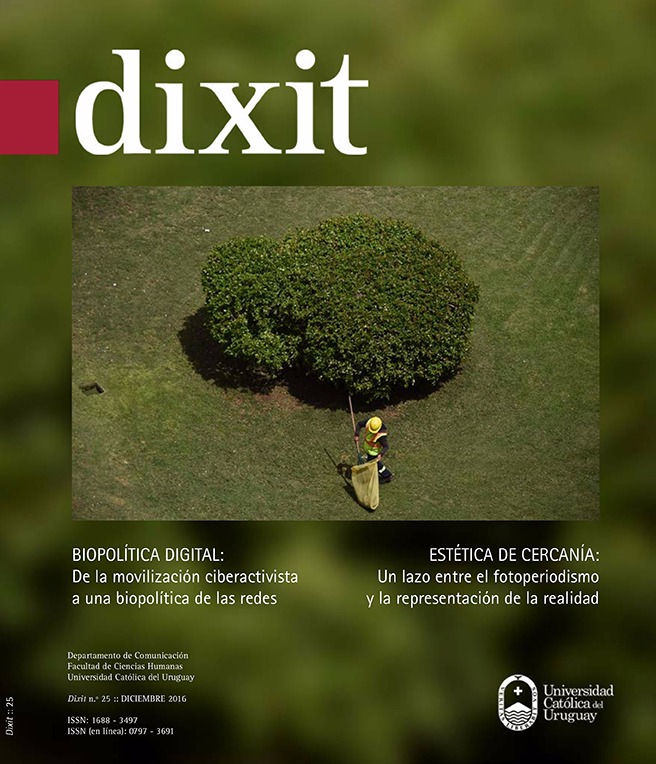Hope and fear: a theoretical approach to the emotions in political communication
DOI:
https://doi.org/10.22235/d.v0i25.1271Keywords:
emotion, reason, political communication, affective intelligence, social mediaAbstract
The Western philosophy postulates present reason and emotion as antagonistic forces that motivate individuals in their everyday decision making. In the Western culture, reason has had to dominate emotion so as to reach objective decisions. Habermas hypothesis about the rational dimension of the public sphere reaffirms this tendency that states the public domain should find an order based on rational principles. Although rationalism is still predominant among Social Science researchers, a change in the approaches is evident: emotions have begun to be included in studies when the comprehension of contemporary phenomenon is necessary. Particularly, in the political communication field, emotion as a topic of exploration is new. However, new disciplinary perspectives allow innovating in research inquiries. The aim of this article is to examine literature about the main postulates of the Affective Intelligence Theory which, with Neuroscience, offer other perspectives to the political communication field.
Downloads
References
Amado, A. (2013). La épica no es fiesta [El drama como estilo de comunicación del gobierno argentino]. Perspectivas, 8, 2–6.
Aruguete, N. y Riorda, M. (2014). ¿Ideología u homogeneización? un análisis de las campañas electorales de Argentina, México y Venezuela. Revista Mexicana de Opinión Pública, 16, 31–49.
Banning, S. y Coleman, R. (2009). Louder than words. Visual Communication Quaterly, 16, 4–17.
Bennett, W. (2012). The Personalization of Politics: Political Identity, Social Media, and Changing Patterns of Participation. The ANNALS of the American Academy of Political and Social Science, 644(1), 20–39. http://doi.org/10.1177/0002716212451428
Bennett, W. L. (1998). The uncivic culture: Communication, identity, and the rise of lifestyle politics. P&S: Political Science & Politics, 31(4), 740–761.
Bennett, W. L., e Iyengar, S. (2008). A New Era of Minimal Effects? The Changing Foundations of Political Communication. Journal of Communication, 58(4), 707–731. http://doi.org/10.1111/j.1460-2466.2008.00410.x
Blumler, J. G., y Gurevitch, M. (1995). The Crisis of Public Communication [Versión Kindle]. London: Routledge.
Blumler, J. G., y Kavanagh, D. (1999). The Third Age of Political Communication: Influences and Features. Political Communication, 16(3), 209–230. http://doi.org/10.1080/105846099198596
Brader, T. (2005). Striking a responsive chord: How political ads motivate and persuade voters by appealing to emotions. American Journal of Political Science, 48(2), 388–405. http://doi.org/10.1111/j.0092-5853.2005.00130.x
Brader, T. (2006). Campaigning for Hearts and Minds, How Emotional Appeals in Political Ads Work. Chicago: University of Chicago.
Castells, M. (2008). Comunicación, poder y contrapoder en la sociedad red (I). Los medios y la política. Telos: Cuadernos de Comunicación e Innovación, 74, 13–24. Recuperado de http://dialnet.unirioja.es/servlet/articulo?codigo=2545714
Castells, M. (2009). Comunicación y poder. Barcelona: Alianza.
Castells, M. (2012). Redes de indignación y esperanza. Los movimientos sociales en la era de internet. Barcelona: Alianza.
Chaffee, S. y Schleuder, J. (1986). Measurement and effects of attention to media news. Human Communication Research, 13 (1), 76-107.
Coleman, R. y Wu, H. D. (2010). Visual Cues in the Formation of Affect. Coleman, R. y Wu, H. D. (Eds.). Image and Emotion in Voter Decisions: The Affect Agenda. London: Lexington Books.
Dahlgren, P. (2012). Tracking the Civic Subject in the Media Landscape: Versions of the Democratic Ideal. Television & New Media, 14 (1), 71–88. http://doi.org/10.1177/1527476412458809
Damasio, A. (1994). Descartes`s Error. New York: Avon Books. http://doi.org/10.7202/051028ar
Damasio, A. (2007). En busca de Spinoza. España: Drakontos.
Dang-Xuan, L., Stieglitz, S., Wladarsch, J. y Neuberger, C. (2013). An Investigation of Influentials and the Role of Sentiment in Political Communication on Twitter During Election Periods. Information, Communication & Society, 16(5), 795–825. http://doi.org/10.1080/1369118X.2013.783608
Espinosa Pezzia, A. (2008). Decidiéndose por el mal menor: El rol de las emociones en las elecciones peruanas del 2006. Psicología Política, 37, 47–70.
Eveland, W. (2004). The effect of political discussion in producing informed citizens: The roles of information, motivation, and elaboration. Political Communication, 21 (2), 177-193.
García Beaudoux, V., D’Adamo, O. y Slavinsky, G. (2011). Propaganda gubernamental. Tácticas e iconografías del poder. Buenos Aires: La Crujía.
Gutiérrez-Rubí, A. (2009). Micropolítica: Ideas para cambiar la comunicación política. Recuperado de http://www.gutierrez-rubi.es/wp-content/uploads/2010/01/libro_micropolitica.pdf
Hatfield, E., Cacioppo, J. y Apson, R. (1994). Emotional Contagion. New York: Cambridge University Press.
Iyengar, S. y Kinder, D. (1987). News that matters: Television and American Opinion. Chicago: University of Chicago Press.
Jerit, J. (2004). Survival of the Fittest: Rethoric during the Course of an Election Cam- paign. Political Psicology, 25, 563–575.
Just, M., Crigler, A. y Belt, T. (2007). “Don´t give up hope”. Emotions, Candidate, Appraisal and Votes. Marcus, G. E., Russell, N. W., Mackuen, M. y Crigler, A. (Eds.). The affect effect, dynamics of emotion in political thinking and behavior (pp. 231-259). Chicago: University of Chicago Press.
Katz, E. y Lazarsfeld, P. (1955). Personal influence. Nueva York: The Free Press.
Lakoff, G. (2007). No pienses en un elefante: lenguaje y debate político. Madrid: Editorial Complutense.
Lang, A. (1994). How they predict memory for Television Messages. Presentado en el Annual Meeting of the Association for Education in Journalism and Mass Communication. Atlanta, Estados Unidos.
Lang, A. (2000). The limited capacity model of mediated message processing. Journal of Communication, 50, 46–70. http://doi.org/10.1111/j.1460-2466.2000.tb02833.x
LeDoux, J. (1996). The Emotional Brain. London: Phoenix.
López-Escobar, E. y Llamas, J. P. (1996). Agenda-setting: investigaciones sobre el primer y el segundo nivel. Comunicación y Sociedad, 9 (2), 9–15.
Marcus, G. E. (2002). The Sentimental Citizen, Emotion in Democratic Politics. Pennsylvania: Pennsylvania State University Press.
Marcus, G., Neuman, R. y Mackuen, M. (2000). Affective Intelligence and Political Judgment. Chicago: The University of Chicago Press.
McCombs, M. y Shaw, D. (1974, agosto). A Progress Report on Agenda-setting Research. Paper presentado en la reunión anual de la Association for Education in Journalism, San Diego, CA.
Miller, J. M. (2007). Examining the Mediators of Agenda-Setting: A New Experimental Paradigm Reveals the Role of Emotions. International Society of Political Psychology, 28(6), 689–717.
Moy, P. y Gastil, J. (2006). Predicting Deliberative Conversation: The Impact of Discussion Networks, Media Use, and Political Cognitions. Political Communication, 23(4), 443–460. http://doi.org/10.1080/10584600600977003
Plummer, K. (2003). Intimate Citizenship. Seattle: University of Washington Press.
Reese, S. D. (2001). Framing Public Life: A Bridging Model for Media Research. Reese, S., Gandy, O. y Grant, A. (Eds.). Framing Public Life: A Bridging Model for Media Research (pp. 7–31). Mahwah, New Jersey: Lawrence Erlbaum.
Rincón, O. (2011). Mucho ciberactivismo... pocos votos. Nueva Sociedad, 235, 74–89. Recuperado de http://library.fes.de/pdf-files/nuso/nuso-235.pdf
Rincón, O., y Bonilla, J. I. (2004). Comunicación Política en América Latina. Bogotá: Centro de Competencia en Comunicación para América Latina. Recuperado de http://www.fesmedia-latin-america.org/uploads/media/Comunicaci%C3%B3n_pol%C3%ADtica_en_Am%C3%A9rica_Latina.pdf
Russell, N. W., Marcus, G., Crigler, A. y Mackuen, M. (2007). Affect Effect. Dynamics of emotion in polititical thinking and behaviour. Chicago: University of Chicago.
Scherer, K. R. (2005). What are emotions? And how can they be measured? Social Science Information, 44(4), 695–729. http://doi.org/10.1177/0539018405058216
Stieglitz, S. y Dang-Xuan, L. (2013). Emotions and Information Diffusion in Social Media—Sentiment of Microblogs and Sharing Behavior. Journal of Management Information Systems, 29(4), 217–248. http://doi.org/10.2753/MIS0742-1222290408
Valentino, N., Hutchings, T., Banks, A. y Davis, A. (2008). Is a worried citizen a good citizen? Emotions, political information seeking, and learning via the internet. Political Psicology, 29 (2), 247-273.
Valenzuela, S. (2011). The Affective Citizen Communication Model: How Emotions Engage Citizens with Politics through Media and Discussion. ProQuest Dissertations and Theses, 198. Recuperado de http://search.proquest.com/docview/906381170
Westen, D. (2008). The emotional brain. New York: Public Affairs.
Wolton, D. (2005). Elogio del gran público. Buenos Aires: Gedisa.
Downloads
Published
How to Cite
Issue
Section
License
From issue number 32 onwards all contents are licensed under the Creative Commons Attribution 4.0 International License (CC BY 4.0).
Issues number 29-31 are licensed under the Creative Commons Attribution-NonCommercial 4.0 International License.
The contents corresponding to number 28 and earlier editions are under the Creative Commons Attribution-NonCommercial-ShareAlike 4.0 International License.


















